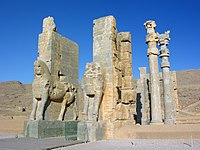
Photo from wikipedia
The papers (with the exception of two) in this special issue of Iranian Studies were presented in a series of conferences on Ottoman–Iranian encounters in Retz, Istanbul, and Vienna. Given… Click to show full abstract
The papers (with the exception of two) in this special issue of Iranian Studies were presented in a series of conferences on Ottoman–Iranian encounters in Retz, Istanbul, and Vienna. Given the contested and militarized nature of this borderland as well as its relevance to contemporary events in the Middle East, the organizers and the editor of the journal felt that it was crucial to publish these papers together in a special issue and approach the history of this region from a different spatial dimension (periphery rather than center) and a more critical perspective than the current trends in nationalist historiographies. Moreover, as contributors, we felt that it was important to tackle narrative as well as archival sources in different languages, offer multiple readings of the same sources, and provide a critical perspective on official chronicles and narratives from both Ottoman and Safavid sides. Moreover, the study of confessional, political as well as military and diplomatic history of this borderland in the early modern period was crucial to a better understanding of developments in the later periods (nineteenth and twentieth centuries). As a few of the papers demonstrate, the confessional divide was only one aspect of the complex history of the region that developed later and in fact the diversity (ethno-linguistic, religious, social) and fluidity of this porous borderland on both sides were stable features of the early modern period and through most of the nineteenth century. The emergence of territorial sovereignty in the nineteenth century, the clash of old and new empires (Russia and Great Britain in particular) over the control of the borderland, the emergence of various movements for nationalism and self-determination, as well as the struggle for secular modernity and the two world wars all had profound impact on our borderland (eastern Anatolia, Iranian Studies, 2019 Vol. 52, Nos. 3–4, 291–297, https://doi.org/10.1080/00210862.2019.1646388
Journal Title: Iranian Studies
Year Published: 2019
Link to full text (if available)
Share on Social Media: Sign Up to like & get
recommendations!